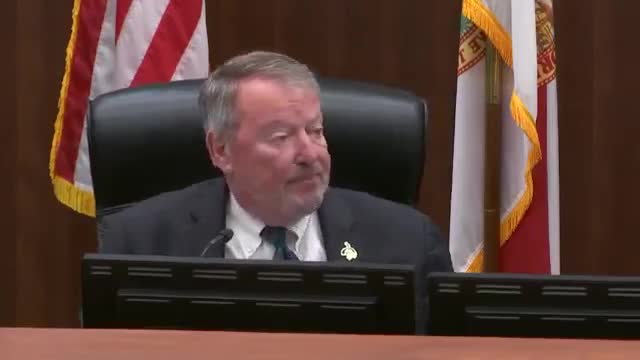Orlando council approves expansion of red-light cameras from 25 to 80 intersections
October 20, 2025 | Orlando, Orange County, Florida
This article was created by AI summarizing key points discussed. AI makes mistakes, so for full details and context, please refer to the video of the full meeting. Please report any errors so we can fix them. Report an error »

The Orlando City Council voted to expand the city’s red‑light camera program from 25 intersections to 80 on Oct. 20, citing a five‑year crash study that identified locations with heightened safety risk.
Raymond Rodriguez, manager of the Orlando Stop Traffic Safety Program, told the council the study reviewed 2,006 crashes from January 2020 through December 2024 and focused on crash types most commonly associated with red‑light running: left‑turn, right‑turn and angle collisions. Rodriguez said the study applied three criteria to designate a location as a “heightened safety risk”: an existing red‑light camera location, a crash at the intersection that resulted in a death, or a composite crash score of 20 or higher that combines vulnerability of road users and severity of injury.
"A score of 20 or higher indicates that it is a heightened safety risk," Rodriguez said. He told the council the analysis identified 80 signalized intersections that meet at least one criterion and therefore warrant additional enforcement.
The council’s action followed questions about how the program operates and how camera revenues are used. Laura Hardwick, safe mobility manager in the transportation department, said citation revenue covers operations and is routed to the city’s transportation safety fund, which she estimated at roughly $400,000 to $700,000 a year. She said funds support Vision Zero safety projects and that project selection looks at several factors including proximity to camera locations.
"We play a delicate dance of making sure we get safety projects made," Hardwick said, adding that safety projects eligible for the fund are prioritized when they are within about a mile of a camera location.
Council members pressed for more data and for ways to address related safety problems. Commissioner Sheehan said she strongly supported the expansion and asked whether cameras can be used to address illegal turns; Rodriguez replied that the current camera enforcement addresses red‑light violations and that cameras cannot cite illegal turns when the signal is green. Commissioner Stewart asked whether a warning period is possible; Rodriguez said state law allows a 30‑day warning period after a camera is first operational.
A member of the public, Patrick Panza of Blackhawk Central Florida, spoke in favor of the expansion and urged the council to invest any program revenue in roadway and pedestrian safety projects.
The ordinance expanding the program (Ordinance 2025‑37) was moved by Commissioner Sheehan, seconded by Commissioner Stewart, and approved by voice vote. The council did not record individual roll‑call votes in the transcript.
Council members and staff framed the policy as aimed at reducing severe and fatal crashes and supporting the city’s stated Vision Zero goal.
Raymond Rodriguez, manager of the Orlando Stop Traffic Safety Program, told the council the study reviewed 2,006 crashes from January 2020 through December 2024 and focused on crash types most commonly associated with red‑light running: left‑turn, right‑turn and angle collisions. Rodriguez said the study applied three criteria to designate a location as a “heightened safety risk”: an existing red‑light camera location, a crash at the intersection that resulted in a death, or a composite crash score of 20 or higher that combines vulnerability of road users and severity of injury.
"A score of 20 or higher indicates that it is a heightened safety risk," Rodriguez said. He told the council the analysis identified 80 signalized intersections that meet at least one criterion and therefore warrant additional enforcement.
The council’s action followed questions about how the program operates and how camera revenues are used. Laura Hardwick, safe mobility manager in the transportation department, said citation revenue covers operations and is routed to the city’s transportation safety fund, which she estimated at roughly $400,000 to $700,000 a year. She said funds support Vision Zero safety projects and that project selection looks at several factors including proximity to camera locations.
"We play a delicate dance of making sure we get safety projects made," Hardwick said, adding that safety projects eligible for the fund are prioritized when they are within about a mile of a camera location.
Council members pressed for more data and for ways to address related safety problems. Commissioner Sheehan said she strongly supported the expansion and asked whether cameras can be used to address illegal turns; Rodriguez replied that the current camera enforcement addresses red‑light violations and that cameras cannot cite illegal turns when the signal is green. Commissioner Stewart asked whether a warning period is possible; Rodriguez said state law allows a 30‑day warning period after a camera is first operational.
A member of the public, Patrick Panza of Blackhawk Central Florida, spoke in favor of the expansion and urged the council to invest any program revenue in roadway and pedestrian safety projects.
The ordinance expanding the program (Ordinance 2025‑37) was moved by Commissioner Sheehan, seconded by Commissioner Stewart, and approved by voice vote. The council did not record individual roll‑call votes in the transcript.
Council members and staff framed the policy as aimed at reducing severe and fatal crashes and supporting the city’s stated Vision Zero goal.
View full meeting
This article is based on a recent meeting—watch the full video and explore the complete transcript for deeper insights into the discussion.
View full meeting